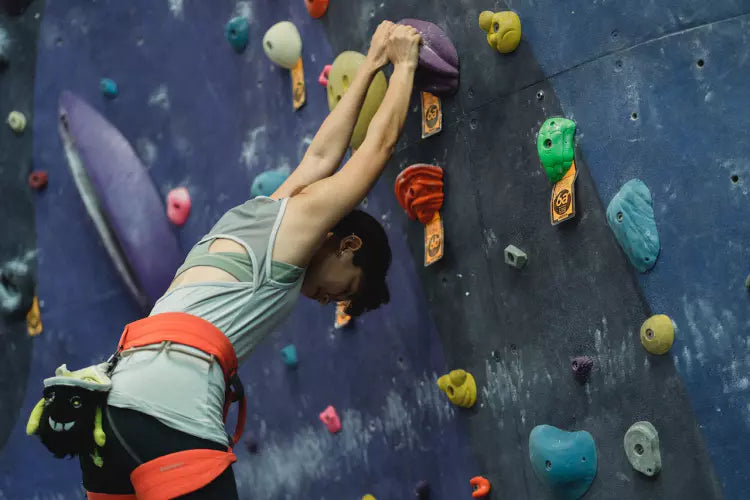
The Last Warm-Up for Climbing You’ll Ever Need
Why is warming up for climbing important?
Before learning about the last warm-up for climbing you’ll ever need, you must understand why warming up is so important. First and foremost, warming up properly prevents injury. It’s called “warming up” because you are physiologically raising the temperature in your body. Warmer muscles, tendons, and joints become more flexible, which helps them stretch into extreme positions without causing a strain or tear. Secondly, an excellent warm-up regimen can improve your performance on the wall. When you warm up, your body sends more blood and oxygen to the muscles. Increased oxygen means that your body can use the strength in those muscles more efficiently. Every climber wants to avoid injury and perform better, and warming up properly is an excellent way to ensure both of these happen.

The funnel warm-up
The funnel warm-up includes four different steps to perform in a particular order. Picture a funnel. It’s wide at the top and narrow at the bottom. Now, split the funnel in your mind into four different sections from top to bottom. The section at the top is the widest, and the area at the bottom is the narrowest. Each section will be a different step in your warm-up, starting with the top section. The first step is the widest section because the goal is to warm up your entire body with a little cardio. The second step gets a bit narrower because we focus on warming the whole body but targeting some specific spots with dynamic stretching. The third step is when we move to climbing-specific big muscle groups. And the final step, the narrowest section of the funnel, is spending extra attention warming up your small, climbing-specific muscle groups, like your finger tendons.
Elevate that heart rate
Elevating your heart rate at the start of your warm-up is vital to raise the overall temperature of your entire body. As your internal temperature increases with this rise in your heart rate, your muscles become looser and ready for some stretching. A light jog, row, or cycle are a few effective cardio exercises that can increase your heart rate appropriately. Try to increase your speed ever so slightly for about 5-10 minutes. These exercises are easy on the body, so if you are looking for more advanced cardio warm-up exercises, you can try burpees, jump squats, jumping rope, or pushups. As long as these exercises are manageable for your ability level, they are all tremendous warm-ups.
Dynamic stretching
The next step in the funnel is dynamic stretching. Now that you have raised your internal body temperature, your muscles are warm enough to be stretched. Dynamic stretching is essential in a proper warm-up to stretch your muscles while also going through your range of motion. That mimics climbing since you will stretch your muscles while activating them in an extreme range of motion as you climb. That is the perfect time to target specific muscle groups that are either sore or more critical for climbing (like shoulders, back, and hamstrings). A few great examples of dynamic stretches for climbing include leg swings, walking lunges, cat-cow, hip-openers, arm circles, and finger flicks.

Climbing-specific big muscle group warm-up
The third section of the funnel is when it’s time to get on the wall. In this step, you target warming up big muscle groups by climbing. The big muscle groups are your shoulders, back muscles, and legs. You want to avoid getting pumped during this warm-up phase. Start on boulder problems that are easy for you, and climb them normally. Once completed, climb at the same difficulty level, but this time focus on skipping holds and moving dynamically through the boulders. That will start to warm up your shoulder and back muscles. Once those big muscle groups feel warm, climb on the same difficulty level, focusing on using your legs as much as possible explosively.
Climbing-specific small muscle warm-up
The final step of a proper warm-up is making sure those forearms and finger tendons are warm and ready to pull hard. Getting a flash pump can ruin your entire climbing session, and tweaking a finger tendon can ruin the next week of climbing, so this is arguably the most crucial step in warming up. When warming up the forearms, try climbing an easy-for-you boulder problem up and down, rest, and then climb it up, down, and then up again. If you’re warming up your forearms and suddenly feel an aggressive pump come on quickly, stop because you are approaching a flash pump. Take it slowly and allow those forearms to warm up properly. Recruitment pulls or easy hangs (with feet on) on the hangboard are excellent options for your finger tendons. Make sure your fingers aren’t pulling too hard initially, and progress the difficulty slowly. Another way to warm up the finger tendons is to pull on more complicated boulder problems with progressively smaller holds.
Once you start warming up following the funnel method, you’ll never stray! It’ll leave you feeling good, strong, and in control of your body at the start of every climbing session.

























